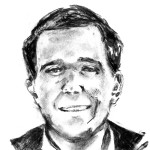In his freshman address, Yale College Dean Jonathan Holloway characterized Yale as “ever-evolving.” He noted that the freshman class of 1965 would hardly recognize the University that exists today and suggested that the Yale of 2065 will be “quite distinct from what [our] present collective imagination can summon.”
 I have little doubt that Holloway is correct. If anything, I think he is conservative in his estimate, considering the rapid pace at which Yale is changing. By the time the class of 2019 graduates, the two new colleges will have opened. The $150 million student center will be only months from completion. The overhaul of our administration, which has been restructured and turned over at an unprecedented rate over the last few years, will have likely settled. Yale is at a hinge point in history today, and I doubt our collective imagination can summon what it will look like in 2025, much less 2065.
I have little doubt that Holloway is correct. If anything, I think he is conservative in his estimate, considering the rapid pace at which Yale is changing. By the time the class of 2019 graduates, the two new colleges will have opened. The $150 million student center will be only months from completion. The overhaul of our administration, which has been restructured and turned over at an unprecedented rate over the last few years, will have likely settled. Yale is at a hinge point in history today, and I doubt our collective imagination can summon what it will look like in 2025, much less 2065.
As a senior, my personal stake in this transition is limited. As a class, our chance to impact the community has more or less come and gone, and this last year is mostly a victory lap. I primarily took up this column to devote most of my writing to the day-to-day issues which annoy the average Yalie, such as being nickeled-and-dimed by an infestation of $50 fines, the Lucky Charms knock-offs labeled Lucky Charms and losing Christmas.
However, as someone who loves Yale, I feel compelled to express my concerns about the scale and speed of change affecting this community. Holloway characterized our present discussion as our University engaging “with questions of its own identity.” Such a fundamental challenge should inspire all of us to think about what Yale means.
I understand that some change is necessary, and I am sure many of the potential developments facing our University will be positive. Frankly, some of today’s campus discussions, such as whether or not it is appropriate to have a college named after one of the great villains of American history, seem overdue.
But most of my reflections on questions of Yale’s evolving identity focus on what we shouldn’t lose. I worry that in the hullabaloo and turnover, we might lose our culture.
Yale is a great university, but there are many great universities. What distinguishes us is our community, our sense of belonging. Even Harvard acknowledged as much in the famed Crimson article, “The Cult of the Bulldog.”
I know it’s a tired line. People throw out platitudes about Wenzels and Toad’s and residential colleges, and the allusions become hackneyed and lose their meaning. But the sense of what they’re getting at is real, and an anecdote from last year shows as much.
In October 2014, someone drew a swastika on Old Campus. It was quickly removed, and at many institutions, that would have been the end of the story. But here, it wasn’t. Holloway sent a campuswide email acknowledging the act and denouncing it. Memorably, he wrote, “There is no room for hate in this house.”
The next morning, at the site where the swastika had been drawn, the same message was repeated, decorated by vibrant colors, encouraging words and symbols of love. There was no organization of the effort, nor any coordination. It was a simple, spontaneous, grassroots act affirming our sense of community in a powerful and unspoken way.
In this time of institutional transformation, this story bears repeating. It represents the best of us. Yale will be very different in the near future. Events like the Parade of Comestibles may no longer be possible once we no longer have the physical capacity for them. The college may cease to be the heart of the University and instead take on a more co-equal position with the graduate and professional schools. Yale’s signature classes, the kind written about in The New York Times and The Wall Street Journal, will likely be less accessible.
Not all of these changes are within our control, but we can do our part to preserve Yale’s culture. No matter what the colleges are named, or how many of them we have, or how many new administrators there are, it is ultimately up to us to choose how we interact with each other. It is those interactions that shape our identity as an institution. I think I have seen Yale at its best, in this respect. As we begin this season of change, I hope our sense of community holds.
Michael Herbert is a senior in Saybrook College. His column runs on alternate Tuesdays. Contact him at michael.herbert@yale.edu .







